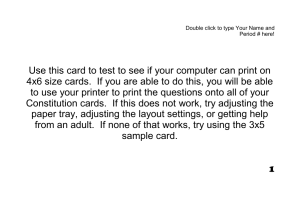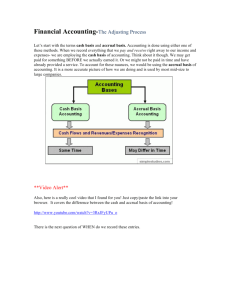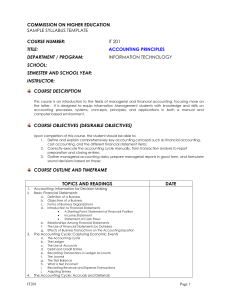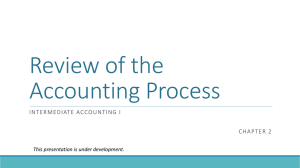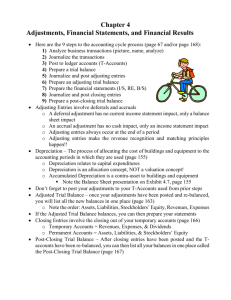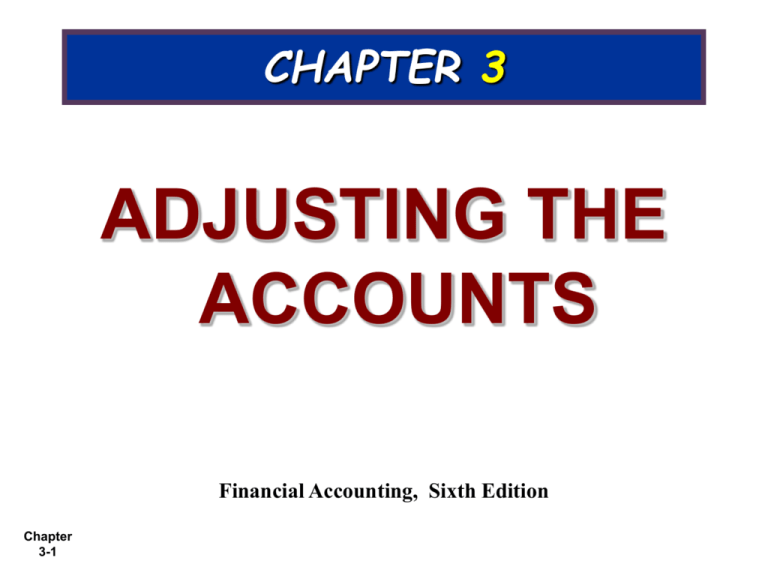
CHAPTER 3
ADJUSTING THE
ACCOUNTS
Financial Accounting, Sixth Edition
Chapter
3-1
Study Objectives
1.
Explain the time period assumption.
2. Explain the accrual basis of accounting.
3. Explain the reasons for adjusting entries.
4. Identify the major types of adjusting entries.
5. Prepare adjusting entries for deferrals.
6. Prepare adjusting entries for accruals.
7. Describe the nature and purpose of an adjusted
trial balance.
Chapter
3-2
Adjusting the Accounts
Timing Issues
Chapter
3-3
The Basics of
Adjusting
Entries
Time period
assumption
Types of adjusting
entries
Fiscal and
calendar years
Adjusting entries
for deferrals
Accrual- vs. cashbasis accounting
Adjusting entries
for accruals
Recognizing
revenues and
expenses
Summary of
journalizing and
posting
The Adjusted
Trial Balance and
Financial
Statements
Preparing the
adjusted trial
balance
Preparing
financial
statements
Timing Issues
Accountants divide the economic life of a
business into artificial time periods
(Time Period Assumption).
.....
Jan.
Feb.
Mar.
Apr.
Dec.
Generally a month, a quarter, or a year.
Fiscal year vs. calendar year
Also known as the “Periodicity Assumption”
Chapter
3-4
LO 1 Explain the time period assumption.
Timing Issues
Review
The time period assumption states that:
a. revenue should be recognized in the accounting
period in which it is earned.
b. expenses should be matched with revenues.
c.
the economic life of a business can be divided
into artificial time periods.
d. the fiscal year should correspond with the
calendar year.
Chapter
3-5
LO 1 Explain the time period assumption.
Timing Issues
Accrual- vs. Cash-Basis Accounting
Accrual-Basis Accounting
Transactions recorded in the periods in which
the events occur
Revenues are recognized when earned, rather
than when cash is received.
Expenses are recognized when incurred, rather
than when paid.
Chapter
3-6
LO 2 Explain the accrual basis of accounting.
Timing Issues
Accrual- vs. Cash-Basis Accounting
Cash-Basis Accounting
Revenues are recognized when cash is received.
Expenses are recognized when cash is paid.
Cash-basis accounting is not in accordance with
generally accepted accounting principles (GAAP).
Chapter
3-7
LO 2 Explain the accrual basis of accounting.
Timing Issues
Recognizing Revenues and Expenses
Revenue Recognition Principle
Companies recognize
revenue in the accounting
period in which it is
earned.
In a service enterprise,
revenue is considered to
be earned at the time the
service is performed.
Chapter
3-8
LO 2 Explain the accrual basis of accounting.
Timing Issues
Recognizing Revenues and Expenses
Matching Principle
Match expenses with
revenues in the period
when the company makes
efforts to generate
those revenues.
“Let the expenses follow
the revenues.”
Chapter
3-9
LO 2 Explain the accrual basis of accounting.
Timing Issues
GAAP relationships
in revenue and
expense recognition
Illustration 3-1
Chapter
3-10
LO 2 Explain the accrual basis of accounting.
Timing Issues
Review
One of the following statements about the accrual basis
of accounting is false. That statement is:
a. Events that change a company’s financial
statements are recorded in the periods in which
the events occur.
b. Revenue is recognized in the period in which it is
earned.
c. The accrual basis is in accord with generally
accepted accounting principles.
d. Revenue is recorded only when cash is received, and
expense is recorded only when cash is paid.
Chapter
3-11
LO 2 Explain the accrual basis of accounting.
The Basics of Adjusting Entries
Adjusting entries make it possible to report
correct amounts on the balance sheet and on
the income statement.
A company must make adjusting entries
every time it prepares financial statements.
Chapter
3-12
LO 3 Explain the reasons for adjusting entries.
The Basics of Adjusting Entries
Revenues - recorded in the period in which
they are earned.
Expenses - recognized in the period in which
they are incurred.
Adjusting entries - needed to ensure that the
revenue recognition and matching principles
are followed.
Chapter
3-13
LO 3 Explain the reasons for adjusting entries.
Timing Issues
Review
Adjusting entries are made to ensure that:
a. expenses are recognized in the period in which
they are incurred.
b. revenues are recorded in the period in which
they are earned.
c. balance sheet and income statement accounts
have correct balances at the end of an
accounting period.
d. all of the above.
Chapter
3-14
LO 3 Explain the reasons for adjusting entries.
Types of Adjusting Entries
Deferrals
1. Prepaid Expenses. Expenses paid in cash and recorded as
assets before they are used or consumed.
2. Unearned Revenues. Cash received and recorded as
liabilities before revenue is earned.
Accruals
1. Accrued Revenues. Revenues earned but not yet received in
cash or recorded.
2. Accrued Expenses. Expenses incurred but not yet paid in
cash or recorded.
Chapter
3-15
LO 4 Identify the major types of adjusting entries.
Trial Balance
Trial Balance – Each account is analyzed to determine
whether it is complete and up-to-date.
Account
PIONEER ADVERTISING AGENCY INC.
Trial Balance
October 31, 2008
Debit
Cash
Advertising Supplies
Prepaid Insurance
Office Equipment
Notes Payable
Accounts Payable
Unearned Revenue
Common Stock
Retained Earnings
Dividends
Service Revenue
Salaries Expense
Rent Expense
Chapter
3-16
Credit
$ 15,200
2,500
600
5,000
$ 5,000
2,500
1,200
10,000
0
500
10,000
4,000
900
$28,700
$ 28,700
LO 4 Identify the major types of adjusting entries.
Adjusting Entries for Deferrals
Deferrals are either:
Prepaid expenses or
Unearned revenues.
Chapter
3-17
LO 5
Prepare adjusting entries for deferrals.
Adjusting Entries for “Prepaid Expenses”
Payment of cash, that is recorded as an asset because
service or benefit will be received in the future.
Cash Payment
BEFORE
Expense Recorded
Prepayments often occur in regard to:
insurance
supplies
Advertising
rent
Chapter
3-18
building
purchases
equipment
purchases
LO 5
Prepare adjusting entries for deferrals.
Adjusting Entries for “Prepaid Expenses”
Prepaid Expenses
Costs that expire either with the passage of time
or through use.
Adjusting entries
(1) to record the expenses that apply to the
current accounting period, and
(2) to show the unexpired costs in the asset
accounts.
Chapter
3-19
LO 5
Prepare adjusting entries for deferrals.
Adjusting Entries for “Prepaid Expenses”
Illustration 3-4
Adjusting entries for prepaid expenses
Increases (debits) an expense account and
Decreases (credits) an asset account.
Chapter
3-20
LO 5
Prepare adjusting entries for deferrals.
Adjusting Entries for “Prepaid Expenses”
Example (Insurance): On Oct. 4th, Pioneer Advertising
paid $600 for a one-year fire insurance policy. Show the
journal entry to record the payment on Oct 4th.
Oct. 4
Prepaid insurance
600
Cash
600
Prepaid Insurance
Debit
Cash
Credit
Debit
600
Chapter
3-21
Credit
600
LO 5
Prepare adjusting entries for deferrals.
Adjusting Entries for “Prepaid Expenses”
Example (Insurance): On Oct. 4th, Pioneer Advertising paid
$600 for a one-year fire insurance policy. Show the adjusting
journal entry required at Oct. 31st.
Oct. 31
Insurance expense
50
Prepaid insurance
Prepaid Insurance
Debit
600
50
Insurance Expense
Credit
Debit
50
Credit
50
550
Chapter
3-22
LO 5
Prepare adjusting entries for deferrals.
Adjusting Entries for “Prepaid Expenses”
Depreciation
Buildings, equipment, and vehicles (long-lived
assets) are recorded as assets, rather than an
expense, in the year acquired.
Companies report a portion of the cost of a longlived asset as an expense (depreciation) during
each period of the asset’s useful life (Matching
Principle).
Chapter
3-23
LO 5
Prepare adjusting entries for deferrals.
Adjusting Entries for “Prepaid Expenses”
Example (Depreciation): On Oct. 2nd, Pioneer Advertising
paid $5,000 for office equipment that has an expected
useful life of 10 years. Show the journal entry to record
the purchase of the equipment on Oct. 2nd.
Oct. 2
Equipment
5,000
Cash
5,000
Equipment
Debit
Cash
Credit
Debit
5,000
Chapter
3-24
Credit
5,000
LO 5
Prepare adjusting entries for deferrals.
Adjusting Entries for “Prepaid Expenses”
Example (Depreciation): On Oct. 2nd, Pioneer Advertising
paid $5,000 for office equipment that has an expected useful
life of 10 years. Show the adjusting journal entry required at
Oct. 31st. The equipment has a $200 salvage value.
([$5,000- $200 salvage value] / 10 yrs / 12 months = $40)
Jan. 31
Depreciation expense
40
Accumulated depreciation
Depreciation Expense
Debit
Credit
Accumulated Depreciation
Debit
40
40
Credit
40
40
Chapter
3-25
LO 5
Prepare adjusting entries for deferrals.
Adjusting Entries for “Prepaid Expenses”
Depreciation (Statement Presentation)
Accumulated Depreciation—is a contra asset
account.
Appears just after the account it offsets
(Equipment) on the balance sheet.
Office equipment
$5,000
Less: Accumulated depreciation-Office Equipment
Chapter
3-26
LO 5
40
$4,960
Prepare adjusting entries for deferrals.
Adjusting Entries for “Unearned Revenues”
Receipt of cash that is recorded as a liability because
the revenue has not been earned.
Cash Receipt
BEFORE
Revenue Recorded
Unearned revenues often occur in regard to:
rent
magazine subscriptions
customer deposits for
future service
Chapter
3-27
LO 5
sale of airline tickets
school tuition
Prepare adjusting entries for deferrals.
Adjusting Entries for “Unearned Revenues”
Unearned Revenues
Company makes an adjusting entry to record the
revenue that has been earned and to show the
liability that remains.
The adjusting entry for unearned revenues results
in a decrease (a debit) to a liability account and an
increase (a credit) to a revenue account.
Chapter
3-28
LO 5
Prepare adjusting entries for deferrals.
Adjusting Entries for “Unearned Revenues”
Illustration 3-10
Adjusting entries for unearned revenues
Decrease (a debit) to a liability account and
Increase (a credit) to a revenue account.
Chapter
3-29
LO 5
Prepare adjusting entries for deferrals.
Adjusting Entries for “Unearned Revenues”
Example: On Oct. 2nd, Pioneer Advertising received $1,200
from R. Knox for services to be completed by December 31.
Show the journal entry to record the receipt on Oct 2nd.
Oct. 2
Cash
1,200
Unearned Revenue
Cash
Debit
Unearned Rent Revenue
Credit
Debit
1,200
Chapter
3-30
1,200
Credit
1,200
LO 5
Prepare adjusting entries for deferrals.
Adjusting Entries for “Unearned Revenues”
Example: On Oct. 2nd, Pioneer Advertising received $1,200
from R. Knox for services to be completed by December 31.
Show the adjusting journal entry required on Oct. 31st.
Oct. 31
Unearned Revenue
400
Service Revenue
Service Revenue
Debit
400
Unearned Revenue
Credit
Debit
400
400
Credit
1,200
800
Chapter
3-31
LO 5
Prepare adjusting entries for deferrals.
Adjusting Entries for Accruals
Made to record:
Revenues earned and
Expenses incurred
in the current accounting period that have not
been recognized through daily entries.
Chapter
3-32
LO 6
Prepare adjusting entries for accruals.
Adjusting Entries for “Accrued Revenues”
Revenues earned but not yet received in cash or
recorded.
Adjusting entry results in:
Revenue Recorded
BEFORE
Cash Receipt
Accrued revenues often occur in regard to:
interest
rent
services performed
Chapter
3-33
LO 6
Prepare adjusting entries for accruals.
Adjusting Entries for “Accrued Revenues”
Accrued Revenues
An adjusting entry serves two purposes:
(1) It shows the receivable that exists, and
(2) It records the revenues earned.
Chapter
3-34
LO 6
Prepare adjusting entries for accruals.
Adjusting Entries for “Accrued Revenues”
Illustration 3-13
Adjusting entries for accrued revenues
Increases (debits) an asset account and
Increases (credits) a revenue account.
Chapter
3-35
LO 6
Prepare adjusting entries for accruals.
Adjusting Entries for “Accrued Revenues”
Example:
October Pioneer Advertising earned $200 for
advertising services that have not been recorded. Show the
journal entry to record the accrued revenues in October.
In
Oct. 31
Accounts Receivable
200
Service Revenue
Accounts Receivable
Debit
Service Revenue
Credit
Debit
200
Chapter
3-36
200
Credit
200
LO 6
Prepare adjusting entries for accruals.
Adjusting Entries for “Accrued Expenses”
Expenses incurred but not yet paid in cash or
recorded.
Adjusting entry results in:
Expense Recorded
BEFORE
Cash Payment
Accrued expenses often occur in regard to:
interest
rent
Chapter
3-37
taxes
salaries
LO 6
Prepare adjusting entries for accruals.
Adjusting Entries for “Accrued Expenses”
Accrued Expenses
An adjusting entry serves two purposes:
(1) It records the obligations, and
(2) It recognizes the expenses.
Chapter
3-38
LO 6
Prepare adjusting entries for accruals.
Adjusting Entries for “Accrued Expenses”
Illustration 3-16
Adjusting entries for accrued expenses
Increases (debits) an expense account and
Increases (credits) a liability account.
Chapter
3-39
LO 6
Prepare adjusting entries for accruals.
Adjusting Entries for “Accrued Expenses”
Example: On Oct 1st, Pioneer Advertising signed a $,5000, 3month note payable at a rate of 12% per year. The total
interest due on the note at its due date is $150 ($5,000 X
12% X 3/12). Show the journal entry to record the borrowing
on Oct. 1st.
Oct. 1
Cash
5,000
Notes payable
Cash
Debit
Notes Payable
Credit
Debit
5,000
Chapter
3-40
5,000
Credit
5,000
LO 6
Prepare adjusting entries for accruals.
Adjusting Entries for “Accrued Expenses”
Example: On Oct 1st, Pioneer Advertising signed a $,5000, 3month note payable at a rate of 12% per year. The total interest
due on the note at its due date is $150 ([$5,000 x 12%] / 12
months). Show the adjusting journal entry required on Oct.
31st.
Oct. 31
Interest expense
50
Interest payable
Interest Expense
Debit
Interest Payable
Credit
Debit
50
Chapter
3-41
50
Credit
50
LO 6
Prepare adjusting entries for accruals.
Adjusting Entries for “Accrued Expenses”
Accrued Expenses
An adjusting entry serves two purposes:
(1) It records the obligations, and
(2) it recognizes the expenses.
Chapter
3-42
LO 6
Prepare adjusting entries for accruals.
The Adjusted Trial Balance
After all adjusting entries are journalized and
posted the company prepares another trial
balance from the ledger accounts (Adjusted Trial
Balance).
Its purpose is to prove the equality of debit
balances and credit balances in the ledger.
Chapter
3-43
LO 7
Describe the nature and purpose of an adjusted trial balance.
Timing Issues
Review
Which of the following statements is incorrect
concerning the adjusted trial balance?
a. An adjusted trial balance proves the equality of the
total debit balances and the total credit balances in
the ledger after all adjustments are made.
b. The adjusted trial balance provides the primary
basis for the preparation of financial statements.
c. The adjusted trial balance lists the account balances
from largest to smallest.
d. The adjusted trial balance is prepared after the
adjusting entries have been journalized and posted.
Chapter
3-44
LO 7
Describe the nature and purpose of an adjusted trial balance.
Preparing Financial Statements
Financial Statements are prepared directly from the
Adjusted Trial Balance.
Income
Statement
Chapter
3-45
LO 7
Retained
Earnings
Statement
Balance
Sheet
Statement
of Cash
Flows
Describe the nature and purpose of an adjusted trial balance.
Preparing Financial Statements
Account
Debit
Cash
$ 15,200
Accounts Receivable
200
Advertising Supplies
1,000
Prepaid Insurance
550
Office Equipment
5,000
Accumulated Depreciation-Off Equip
Notes Payable
Accounts Payable
Unearned Revenue
Salaries Payable
Interest Payable
Common Stock
Retained Earnings
Dividends
500
Service Revenue
Salaries Expense
5,200
Advertising Supplies Expense
1,500
Rent Expense
900
Insurance Expense
50
Interest Expense
50
Depreciation Expense
40
$ 30,190
Chapter
3-46
LO 7
Credit
Income Statement
PIONEER ADVERTISING AGENCY INC.
Income Statement
For the Month Ended October 31, 2008
$40
5,000
2,500
800
1,200
50
10,000
0
10,600
Revenues
Service Revenue
Expenses
Salaries Expense
5,200
Advertising Supplies Expense1,500
Rent Expense
900
Insurance Expense
50
Interest Expense
50
Depreciation Expense
40
Total expenses
Net income
10,600
7,740
$ 2,860
$ 30,190
Describe the nature and purpose of an adjusted trial balance.
Preparing Financial Statements
Account
Debit
Cash
$ 15,200
Accounts Receivable
200
Advertising Supplies
1,000
Prepaid Insurance
550
Office Equipment
5,000
Accumulated Depreciation-Off Equip
Notes Payable
Accounts Payable
Unearned Revenue
Salaries Payable
Interest Payable
Common Stock
Retained Earnings
Dividends
500
Service Revenue
Salaries Expense
5,200
Advertising Supplies Expense
1,500
Rent Expense
900
Insurance Expense
50
Interest Expense
50
Depreciation Expense
40
$ 30,190
Chapter
3-47
LO 7
Credit
$40
5,000
2,500
800
1,200
50
10,000
0
10,600
Retained Earnings
Statement
PIONEER ADVERTISING AGENCY INC.
Retained Earnings Statement
For the Month Ended October 31, 2008
Retained earnings, October 1
Add: Net income
Less: Dividends
Retained Earnings, October 31
$0
2,860
2,860
500
2,360
$ 30,190
Describe the nature and purpose of an adjusted trial balance.
Preparing Financial Statements
Account
Debit
Cash
$ 15,200
Accounts Receivable
200
Advertising Supplies
1,000
Prepaid Insurance
550
Office Equipment
5,000
Accumulated Depreciation-Off Equip
Notes Payable
Accounts Payable
Unearned Revenue
Salaries Payable
Interest Payable
Common Stock
Retained Earnings
Dividends
500
Service Revenue
Salaries Expense
5,200
Advertising Supplies Expense
1,500
Rent Expense
900
Insurance Expense
50
Interest Expense
50
Depreciation Expense
40
$ 30,190
Chapter
3-48
LO 7
Credit
Balance Sheet
PIONEER ADVERTISING AGENCY INC.
Balance Sheet
October 31, 2008
Assets
$40
5,000
2,500
800
1,200
50
10,000
0
10,600
$ 30,190
Cash
$ 15,200
Accounts Receivable
200
Advertising Supplies
1,000
Prepaid Insurance
550
Office Equipment
$5,000
Accumulated Depreciation-Off Equip
40 4,960
Total Assets
$ 21,910
Liabilities and Stockholders’ Equity
Liabilities
Notes Payable
Accounts Payable
Unearned Revenue
Salaries Payable
Interest Payable
Total liabilities
Stockholders’ Equity
Common Stock
Retained Earnings
Total liabilities and stockholders’ equity
$ 5,000
2,500
800
1,200
50
9,550
10,000
2,360
$ 21,910
Describe the nature and purpose of an adjusted trial balance.
Copyright
“Copyright © 2008 John Wiley & Sons, Inc. All rights reserved.
Reproduction or translation of this work beyond that permitted
in Section 117 of the 1976 United States Copyright Act without
the express written permission of the copyright owner is
unlawful. Request for further information should be addressed
to the Permissions Department, John Wiley & Sons, Inc. The
purchaser may make back-up copies for his/her own use only
and not for distribution or resale. The Publisher assumes no
responsibility for errors, omissions, or damages, caused by the
use of these programs or from the use of the information
contained herein.”
Chapter
3-49


